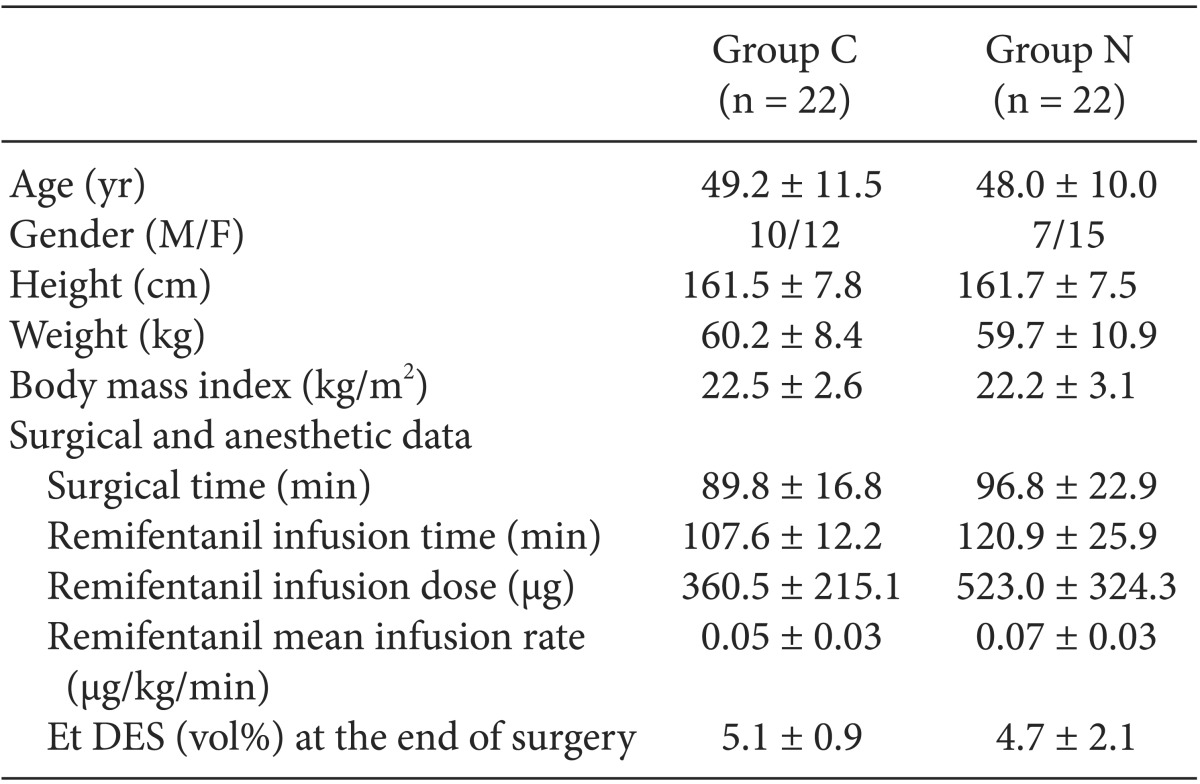1. Mandel JE. Considerations for the use of short-acting opioids in general anesthesia. J Clin Anesth. 2014; 26(1 Suppl):S1–S7. PMID:
24485553.

2. Thompson JP, Rowbotham DJ. Remifentanilan-- opioid for the 21st century. Br J Anaesth. 1996; 76:341–343. PMID:
8785129.

3. Angst MS, Koppert W, Pahl I, Clark DJ, Schmelz M. Short-term infusion of the mu-opioid agonist remifentanil in humans causes hyperalgesia during withdrawal. Pain. 2003; 106:49–57. PMID:
14581110.
4. Chu LF, Angst MS, Clark D. Opioid-induced hyperalgesia in humans: molecular mechanisms and clinical considerations. Clin J Pain. 2008; 24:479–496. PMID:
18574358.
5. Lee C, Kim YD, Kim JN. Antihyperalgesic effects of dexmedetomidine on high-dose remifentanil-induced hyperalgesia. Korean J Anesthesiol. 2013; 64:301–307. PMID:
23646238.

6. Lee H. Opioid-induced hyperalgesia is a paradox for perioperative physician. Korean J Anesthesiol. 2013; 64:1–2. PMID:
23372877.

7. Cho AR, Kim HK, Kim KH, Jung KY, Kim WS, Kwon JY. Effect of remifentanil on postoperative pain in gynecologic surgery with sevoflurane anesthesia. Korean J Anesthesiol. 2008; 55:182–189.

8. Wilder-Smith OH, Arendt-Nielsen L. Postoperative hyperalgesia: its clinical importance and relevance. Anesthesiology. 2006; 104:601–607. PMID:
16508408.
9. Hong BH, Lee WY, Kim YH, Yoon SH, Lee WH. Effects of intraoperative low dose ketamine on remifentanil-induced hyperalgesia in gynecologic surgery with sevoflurane anesthesia. Korean J Anesthesiol. 2011; 61:238–243. PMID:
22025947.

10. Lee C, Song YK, Jeong HM, Park SN. The effects of magnesium sulfate infiltration on perioperative opioid consumption and opioid-induced hyperalgesia in patients undergoing robot-assisted laparoscopic prostatectomy with remifentanil-based anesthesia. Korean J Anesthesiol. 2011; 61:244–250. PMID:
22025948.

11. Rosland JH, Hole K. The effect of nefopam and its enantiomers on the uptake of 5-hydroxytryptamine, noradrenaline and dopamine in crude rat brain synaptosomal preparations. J Pharm Pharmacol. 1990; 42:437–438. PMID:
1979627.

12. Novelli A, Diaz-Trelles R, Groppetti A, Fernández-Sánchez MT. Nefopam inhibits calcium influx, cGMP formation, and NMDA receptor-dependent neurotoxicity following activation of voltage sensitive calcium channels. Amino Acids. 2005; 28:183–191. PMID:
15714253.

13. Evans MS, Lysakowski C, Tramèr MR. Nefopam for the prevention of postoperative pain: quantitative systematic review. Br J Anaesth. 2008; 101:610–617. PMID:
18796441.

14. Kim K, Kim WJ, Choi DK, Lee YK, Choi IC, Sim JY. The analgesic efficacy and safety of nefopam in patient-controlled analgesia after cardiac surgery: A randomized, double-blind, prospective study. J Int Med Res. 2014; 42:684–692. PMID:
24691459.

15. Tirault M, Derrode N, Clevenot D, Rolland D, Fletcher D, Debaene B. The effect of nefopam on morphine overconsumption induced by large-dose remifentanil during propofol anesthesia for major abdominal surgery. Anesth Analg. 2006; 102:110–117. PMID:
16368814.

16. Kim YM, Lim BG, Kim H, Kong MH, Lee MK, Lee IO. Slow injection of nefopam reduces pain intensity associated with intravenous injection: a prospective randomized trial. J Anesth. 2014; 28:399–406. PMID:
24201414.

17. Wittekindt D, Wittekindt C, Meissner W, Guntinas-Lichius O. Postoperative pain assessment after middle ear surgery. HNO. 2012; 60:974–984. PMID:
22767198.
18. Lim BG, Lim SH. Comparison of isoflurane-nitrous oxide anesthesia and isoflurane-remifentanil anesthesia during tympanoplasty. Korean J Anesthesiol. 2008; 54:152–159.

19. Jo HR, Chae YK, Kim YH, Chai HS, Lee WK, Choi SS, et al. Remifentanil-induced pronociceptive effect and its prevention with pregabalin. Korean J Anesthesiol. 2011; 60:198–204. PMID:
21490822.

20. Yoon DG, Jung SH, Ha MH, Song NW. Comparison of ramosetron and ondansetron for preventing nausea and vomiting after middle ear surgery under general anesthesia with sevoflurane and remifentanil. Korean J Anesthesiol. 2009; 56:408–412.

21. Delage N, Maaliki H, Beloeil H, Benhamou D, Mazoit JX. Effective dose (ED50) of nefopam and ketoprofen in postoperative patients: a study of interaction using sequential analysis and isobolographic analysis. Anesthesiology. 2005; 102:1211–1216. PMID:
15915035.
22. Shin SW, Cho AR, Lee HJ, Kim HJ, Byeon GJ, Yoon JW, et al. Maintenance anaesthetics during remifentanil-based anaesthesia might affect postoperative pain control after breast cancer surgery. Br J Anaesth. 2010; 105:661–667. PMID:
20876698.
23. Vinik HR, Kissin I. Rapid development of tolerance to analgesia during remifentanil infusion in humans. Anesth Analg. 1998; 86:1307–1311. PMID:
9620525.

24. Borgland SL. Acute opioid receptor desensitization and tolerance: is there a link? Clin Exp Pharmacol Physiol. 2001; 28:147–154. PMID:
11207668.

25. Jordan B, Devi LA. Molecular mechanisms of opioid receptor signal transduction. Br J Anaesth. 1998; 81:12–19. PMID:
9771268.

26. Kissin I, Bright CA, Bradley EL Jr. Acute tolerance to continuously infused alfentanil: the role of cholecystokinin and N-methyl-D-aspartatenitric oxide systems. Anesth Analg. 2000; 91:110–116. PMID:
10866896.

27. Girard P, Coppe MC, Verniers D, Pansart Y, Gillardin JM. Role of catecholamines and serotonin receptor subtypes in nefopam-induced antinociception. Pharmacol Res. 2006; 54:195–202. PMID:
16750379.

28. Fernandez-Sanchez MT, Diaz-Trelles R, Groppetti A, Manfredi B, Brini AT, Biella G, et al. Nefopam, an analogue of orphenadrine, protects against both NMDA receptor-dependent and independent veratridine-induced neurotoxicity. Amino Acids. 2002; 23:31–36. PMID:
12373515.

29. Durrieu G, Olivier P, Bagheri H, Montastruc JL. Overview of adverse reactions to nefopam: an analysis of the French Pharmacovigilance database. Fundam Clin Pharmacol. 2007; 21:555–558. PMID:
17868209.

30. Aymard G, Warot D, Démolis P, Giudicelli JF, Lechat P, Le Guern ME, et al. Comparative pharmacokinetics and pharmacodynamics of intravenous and oral nefopam in healthy volunteers. Pharmacol Toxicol. 2003; 92:279–286. PMID:
12787260.










 PDF
PDF Citation
Citation Print
Print



 XML Download
XML Download